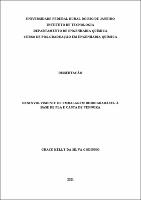Please use this identifier to cite or link to this item:
https://rima110.im.ufrrj.br:8080/jspui/handle/20.500.14407/11156| metadata.dc.type: | Dissertação |
| Title: | Desenvolvimento de embalagem biodegradável à base de PLA e casca de cenoura |
| Other Titles: | Development of biodegradable packaging based on PLA and carrot peel |
| metadata.dc.creator: | Godinho, Grace Kelly da Silva |
| metadata.dc.contributor.advisor1: | Oliveira, Renata Nunes |
| metadata.dc.contributor.advisor-co1: | Meleiro, Cristiane Hess de Azevedo |
| metadata.dc.contributor.referee1: | Oliveira, Renata Nunes |
| metadata.dc.contributor.referee2: | Bastos, Daniele Cruz |
| metadata.dc.contributor.referee3: | Mendes, Marisa Fernandes |
| metadata.dc.description.resumo: | Com o crescente consumo de embalagens plásticas e o impacto negativo de seu descarte inadequado e a saturação dos aterros sanitários e lixões, muitos resíduos são produzidos. Neste caso, a eliminação de resíduos tornou-se uma questão crítica para a construção de uma sociedade ambientalmente correta. Considerando a pressão crescente de recursos limitados e segurança ambiental, os polímeros biodegradáveis podem ser uma forma promissora de facilitar a pressão de eliminação de resíduos plásticos. Geralmente, polímeros biodegradáveis são biopolímeros derivados de recursos renováveis, como sacarídeos, glicolipídeos, lipopolissacarídeos, proteínas e polihidroxialcanoatos. Os polímeros biodegradáveis mais utilizados em pesquisas nacionais e de maior importância são poliácido lático – PLA, polihidroxialcanoatos–PHA, polímeros de amido – PA, goma xantana –Xan. O poli (ácido lático) - PLA é ecologicamente correto, biodegradável e compostável, mas apresenta fragilidade mecânica. Compósitos de PLA contendo bio-resíduos (cascas e sementes) podem ser uma estratégia para a diminuição do descarte dessas matérias-primas. Este trabalho tem como objetivo o desenvolvimento de embalagem biodegradável a base de PLA com a incorporação de casca de cenoura. Foram confeccionadas amostras PLA-casca de cenoura (0, 5, 10, 15 e 25 m/m % casca) por casting. As amostras foram analisadas por FTIR, MEV, teste de textura, teste de degradação em quatro meios diferentes (ácido, básico, água e solo adubado). Os resultados mostram que as amostras em meio aquoso mantiveram praticamente o peso idêntico ao inicial, em meio ácido e básico houve ganho de massa, embora em solo apresentassem perda de massa considerável. Houve diminuição da porosidade do PLA ao adicionar a cenoura, embora a aderência da casca à matriz PLA tenha sido baixa. A resistência mecânica aumentou com o aumento da porcentagem de cenoura no PLA. |
| Abstract: | The increasing use of plastic packaging and the negative impact of its improper disposal,e saturation of landfills and dumps, led to the development of biodegradable packaging. In this case, waste disposal has become a critical issue for building an environmentally friendly society. Considering the increasing pressure of limited resources and environmental safety, biodegradable polymers may be a promising way to ease the pressure to dispose of plastic waste. Generally, biodegradable polymers are biopolymers derived from renewable resources, such as saccharides, glycolipids, lipopolysaccharides, proteins and polyhydroxyalkanoates. The most important biodegradable polymers used in national research are polylactic acid – PLA, polyhydroxyalkanoates–PHA, starch polymers – PA, xanthan gum –Xan.Poly (lactic acid) - PLA is a polymer widely used in packaging studies, since it is environmentally friendly, biodegradable, and compostable, but there are some disadvantages in its properties. The improvement of these properties, using mixtures of peels and seeds, has shown satisfactory results and can be a strategy for the reduction of food residues waste. In this context, the goal of this work was to develop biodegradable packaging based on PLA and carrot peel, aiming at the reuse potential food waste, where the biodegradation of polymeric packaging is a crucial factor. The samples were prepared with 0, 5, 10, 15 and 25 w / w% of carrot peel in PLA. PLA / carrot peel degradation was investigated in four different media: acid, basic, water and composted soil. The results show that the samples in aqueous medium maintained almost the same weight as the initial one, in acidic and basic medium there was mass gain, while in fertilized soil they showed significant mass loss. The results in scanning electron microscopy (SEM) and infrared by Fourier transform (FTIR), showed that there was a decrease in the porosity of the PLA when adding the carrot and little adherence of the carrot to the PLA matrix. The mechanical resistance increased with the increase in the percentage of carrots in the PLA. |
| Keywords: | PLA casca de cenoura biodegradação biodegradable packaging carrot peel |
| metadata.dc.subject.cnpq: | Engenharia Química |
| metadata.dc.language: | por |
| metadata.dc.publisher.country: | Brasil |
| Publisher: | Universidade Federal Rural do Rio de Janeiro |
| metadata.dc.publisher.initials: | UFRRJ |
| metadata.dc.publisher.department: | Instituto de Tecnologia |
| metadata.dc.publisher.program: | Programa de Pós-Graduação em Engenharia Química |
| Citation: | GODINHO, Grace Kelly da Silva. Desenvolvimento de embalagem biodegradável à base de PLA e casca de cenoura. 2021. 58 f. Dissertação (Mestrado em Engenharia Química) - Instituto de Tecnologia, Universidade Federal Rural do Rio de Janeiro, Seropédica, RJ, 2021. |
| metadata.dc.rights: | Acesso Aberto |
| URI: | https://rima.ufrrj.br/jspui/handle/20.500.14407/11156 |
| Issue Date: | 23-Aug-2021 |
| Appears in Collections: | Mestrado em Engenharia Química |
Se for cadastrado no RIMA, poderá receber informações por email.
Se ainda não tem uma conta, cadastre-se aqui!
Files in This Item:
| File | Description | Size | Format | |
|---|---|---|---|---|
| 2021 - Grace Kelly da Silva Godinho.pdf | 2.85 MB | Adobe PDF |  View/Open |
Items in DSpace are protected by copyright, with all rights reserved, unless otherwise indicated.

